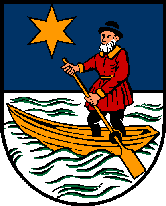St. Wolfgang im Salzkammergut
| St. Wolfgang im Salzkammergut | ||
|---|---|---|
 | ||
| ||
 St. Wolfgang im Salzkammergut Location within Austria | ||
| Coordinates: 47°44′18″N 13°26′53″E / 47.73833°N 13.44806°ECoordinates: 47°44′18″N 13°26′53″E / 47.73833°N 13.44806°E | ||
| Country | Austria | |
| State | Upper Austria | |
| District | Gmunden | |
| Government | ||
| • Mayor | Eisl Franz (ÖVP) | |
| Area | ||
| • Total | 56.6 km2 (21.9 sq mi) | |
| Elevation | 548 m (1,798 ft) | |
| Population (14 June 2016)[1] | ||
| • Total | 2,823 | |
| • Density | 50/km2 (130/sq mi) | |
| Time zone | CET (UTC+1) | |
| • Summer (DST) | CEST (UTC+2) | |
| Postal code | 5360 | |
| Area code | 06138 | |
| Vehicle registration | GM | |
| Website | municipal website | |
St. Wolfgang im Salzkammergut is a market town in central Austria, in the Salzkammergut region of Upper Austria, named after Saint Wolfgang of Regensburg.
Geography
The town is located in central Austria. It is on the northern shore of the Wolfgangsee lake (close to the towns of Strobl and St. Gilgen, both in the State of Salzburg) at the foot of the Schafberg mountain.
Culture
It is famous for the White Horse Inn (Hotel Weißes Rössl), the setting of the musical comedy and for its pilgrimage church with a late Gothic altarpiece by Michael Pacher.
A destination spa, St. Wolfgang is also a popular skiing resort during the winter. A rack railway, the Schafbergbahn runs up the mountain.
History
Saint Wolfgang erected the first church at the shore of the Wolfgangsee after he withdrew to the nearby Mondsee Abbey in 976. According to legend he threw an axe down the mountain to find the site and even persuaded the Devil to contribute to the building by promising him the first living being ever entering the church. However Satan was disappointed as the first creature over the doorstep was a wolf.
After Wolfgang's canonization in 1052, the church became a major pilgrimage site, as it was first mentioned in an 1183 deed by Pope Lucius III. In 1481 it was furnished with the famous Pacher polyptych. There had been several places for lodging around the church since medieval times, while the Weißes Rössl hotel was not built until 1878.
During World War II, a subcamp of the Dachau concentration camp was located here.[2]
Transportation
St. Wolfgang can be reached via a branch of the B 158 Wolfgangsee Straße federal highway (Bundesstraße), running from the city of Salzburg to Bad Ischl.
See also
References
- ↑ Statistik Austria - Bevölkerung zu Jahresbeginn 2002-2016 nach Gemeinden, Erstellt am 14.06.2016 (Last accessed 13.12.2016) for St. Wolfgang im Salzkammergut.
- ↑ "Linde, Land Nordrhein-Westfalen, Germany - Pages: List of subcamps of Dachau - glosk", www.glosk.com, 2010.

